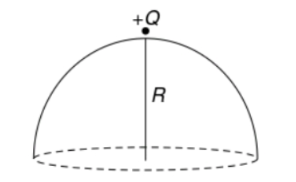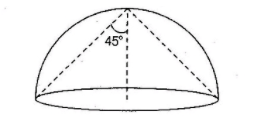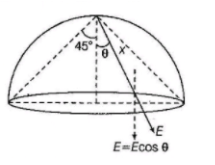
A point charge $+Q$ is placed just outside an imaginary hemispherical surface of radius $R$ as shown in figure. Which of the following statements is/are correct?

(A) The electric flux passing through the curved surface of the hemisphere is $-\dfrac{Q}{2{{\varepsilon }_{0}}}\left( 1-\dfrac{1}{\sqrt{2}} \right)$
(B) The component of the electric field normal to the flat surface is constant over the surface
(C) Total flux through the curved and the flat surfaces is $\dfrac{Q}{{{\varepsilon }_{0}}}$
(D) The circumference of the flat surface is an equipotential

Answer
565.8k+ views
Hint:To find electric flux we use Gauss’ Law. Electric flux is the measure of the electric field through a given area. The electric flux ${{\phi }_{E}}$ through any closed surface is equal to $\dfrac{1}{{{\varepsilon }_{0}}}$ times the net charge $Q$ closed by the surface.
Complete step by step solution:
Given: radius of the hemisphere is $R$
The solid angle subtended by the flat surface at $\Omega =2\pi (1-\cos \theta )$ $...(\text{i})$

From the above figure, we can say that $\theta ={{45}^{\circ }}$
Flux passing through curved surface is given by,
$\phi =-\dfrac{Q}{{{\varepsilon }_{0}}}\times \dfrac{\Omega }{4\pi }$ $...(\text{ii})$
Put the value of equation $(\text{i})$ in equation $(\text{ii})$, we get
$\phi =-\dfrac{Q}{{{\varepsilon }_{0}}}\times \dfrac{2\pi \left( 1-\dfrac{1}{\sqrt{2}} \right)}{4\pi }$
$\phi =-\dfrac{Q}{2{{\varepsilon }_{0}}}\left( 1-\dfrac{1}{\sqrt{2}} \right)$
Hence, the option (A) is correct.
The component of electric field normal to the flat surface is $E\cos \theta $.

Here $E$ and $\theta $ changes for different points on the flat surface. Therefore option (B) is incorrect.
The total flux due to charge $Q$ is $\phi $ and $\phi $ through the curved and flat surface will be less than $\dfrac{Q}{{{\varepsilon }_{0}}}$. Hence option (C) is incorrect.
Potential at any point on the circumference of the flat surface is given by,
$V=\dfrac{1}{4\pi {{\varepsilon }_{0}}}\dfrac{Q}{\sqrt{{{R}^{2}}+{{R}^{2}}}}$
$V=\dfrac{1}{4\pi {{\varepsilon }_{0}}}\dfrac{Q}{\sqrt{2}R}$
Since, the circumference is equidistant from charge $Q$ it will be an equipotential surface.
Therefore option (D) is correct.
Note:An equipotential surface is that at every point electrical potential is the same. The electric field $\vec{E}$ is directed perpendicular to the equipotential surface. Work done in moving charge over an equipotential surface is zero. Two equipotential surfaces can never intersect.
Complete step by step solution:
Given: radius of the hemisphere is $R$
The solid angle subtended by the flat surface at $\Omega =2\pi (1-\cos \theta )$ $...(\text{i})$

From the above figure, we can say that $\theta ={{45}^{\circ }}$
Flux passing through curved surface is given by,
$\phi =-\dfrac{Q}{{{\varepsilon }_{0}}}\times \dfrac{\Omega }{4\pi }$ $...(\text{ii})$
Put the value of equation $(\text{i})$ in equation $(\text{ii})$, we get
$\phi =-\dfrac{Q}{{{\varepsilon }_{0}}}\times \dfrac{2\pi \left( 1-\dfrac{1}{\sqrt{2}} \right)}{4\pi }$
$\phi =-\dfrac{Q}{2{{\varepsilon }_{0}}}\left( 1-\dfrac{1}{\sqrt{2}} \right)$
Hence, the option (A) is correct.
The component of electric field normal to the flat surface is $E\cos \theta $.

Here $E$ and $\theta $ changes for different points on the flat surface. Therefore option (B) is incorrect.
The total flux due to charge $Q$ is $\phi $ and $\phi $ through the curved and flat surface will be less than $\dfrac{Q}{{{\varepsilon }_{0}}}$. Hence option (C) is incorrect.
Potential at any point on the circumference of the flat surface is given by,
$V=\dfrac{1}{4\pi {{\varepsilon }_{0}}}\dfrac{Q}{\sqrt{{{R}^{2}}+{{R}^{2}}}}$
$V=\dfrac{1}{4\pi {{\varepsilon }_{0}}}\dfrac{Q}{\sqrt{2}R}$
Since, the circumference is equidistant from charge $Q$ it will be an equipotential surface.
Therefore option (D) is correct.
Note:An equipotential surface is that at every point electrical potential is the same. The electric field $\vec{E}$ is directed perpendicular to the equipotential surface. Work done in moving charge over an equipotential surface is zero. Two equipotential surfaces can never intersect.
Recently Updated Pages
Master Class 12 Business Studies: Engaging Questions & Answers for Success

Master Class 12 Economics: Engaging Questions & Answers for Success

Master Class 12 English: Engaging Questions & Answers for Success

Master Class 12 Maths: Engaging Questions & Answers for Success

Master Class 12 Social Science: Engaging Questions & Answers for Success

Master Class 12 Chemistry: Engaging Questions & Answers for Success

Trending doubts
What are the major means of transport Explain each class 12 social science CBSE

Which are the Top 10 Largest Countries of the World?

Draw a labelled sketch of the human eye class 12 physics CBSE

Explain sex determination in humans with line diag class 12 biology CBSE

The pH of the pancreatic juice is A 64 B 86 C 120 D class 12 biology CBSE

Give 10 examples of unisexual and bisexual flowers




